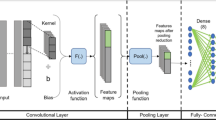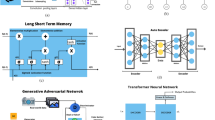Abstract
This article implements a Convolutional Neural Network (CNN)-based deep-learning model for solar-wind prediction. Images from the Atmospheric Imaging Assembly (AIA) at 193 Å wavelength are used for training. Solar-wind speed is taken from the Advanced Composition Explorer (ACE) located at the Lagrangian L1 point. The proposed CNN architecture is designed from scratch for training with four years’ data. The solar-wind has been ballistically traced back to the Sun assuming a constant speed during propagation, to obtain the corresponding coronal-intensity data from AIA images. This forecasting scheme can predict the solar-wind speed well with a RMSE of 76.3 ± 1.87 km s−1 and an overall correlation coefficient of 0.57 ± 0.02 for the year 2018, while significantly outperforming benchmark models. The threat score for the model is around 0.46 in identifying the HSEs with zero false alarms.













Similar content being viewed by others
References
Abadi, M., Agarwal, A., Barham, P., Brevdo, E., Chen, Z., Citro, C., Corrado, G.S., Davis, A., Dean, J., Devin, M., Ghemawat, S., Goodfellow, I., Harp, A., Irving, G., Isard, M., Jia, Y., Jozefowicz, R., Kaiser, L., Kudlur, M., Levenberg, J., Mané, D., Monga, R., Moore, S., Murray, D., Olah, C., Schuster, M., Shlens, J., Steiner, B., Sutskever, I., Talwar, K., Tucker, P., Vanhoucke, V., Vasudevan, V., Viégas, F., Vinyals, O., Warden, P., Wattenberg, M., Wicke, M., Yu, Y., Zheng, X.: 2015, TensorFlow: Large-Scale Machine Learning on Heterogeneous Systems. tensorflow.org.
Bailey, R.L., Reiß, M., Arge, C.N., Möstl, C., Henney, C.J., Owens, M.J., Amerstorfer, U.V., Amerstorfer, T., Weiss, A.J., Hinterreiter, J.: 2021, Using gradient boosting regression to improve ambient solar wind model predictions. Space Weather 9, e2020SW002673. DOI.
Bartels, J.: 1932, Terrestrial-magnetic activity and its relations to solar phenomena. Terr. Magn. Atmos. Electr. 37, 1. DOI.
Bjorck, N., Gomes, C.P., Selman, B., Weinberger, K.Q.: 2018, Understanding batch normalization. In: Bengio, S., Wallach, H., Larochelle, H., Grauman, K., Cesa-Bianchi, N., Garnett, R. (eds.) Adv. Neural Infor. Proc. Syst. 31, Curran Associates, Red Hook, 7694.
Bu, X., Luo, B., Shen, C., Liu, S., Gong, J., Cao, Y., Wang, H.: 2019, Forecasting high-speed solar wind streams based on solar extreme ultraviolet images. Space Weather 17, 1040. DOI.
Cranmer, S.R.: 2009, Coronal holes. Living Rev. Solar Phys. 6, 3. DOI.
Echer, E., Gonzalez, W.D., Tsurutani, B.T., Gonzalez, A.L.C.: 2008, Interplanetary conditions causing intense geomagnetic storms (Dst ≤ −100 nT) during solar cycle 23 (1996–2006). J. Geophys. Res. 113, A05221. DOI.
Gal, Y., Ghahramani, Z.: 2016, Dropout as a Bayesian approximation: representing model uncertainty in deep learning. In: Balcan, M.F., Weinberger, K.Q. (eds.) Proc. 33rd Internat. Conf. Machine Learning, Proc. Machine Learning Res. 48, 1050. New York. proceedings.mlr.press/v48/gal16.html.
Galvez, R., Fouhey, D.F., **, M., Szenicer, A., Muñoz-Jaramillo, A., Cheung, M.C.M., Wright, P.J., Bobra, M.G., Liu, Y., Mason, J., et al.: 2019, A machine-learning data set prepared from the NASA solar dynamics observatory mission. Astron. Astrophys. Suppl. Ser. 242, 7. DOI.
Gonzalez, W.D., Joselyn, J.A., Kamide, Y., Kroehl, H.W., Rostoker, G., Tsurutani, B.T., Vasyliunas, V.M.: 1994, What is a geomagnetic storm? J. Geophys. Res. 99, 5771. DOI.
Gosling, J.T., Pizzo, V.J.: 1999, Formation and evolution of corotating interaction regions and their three dimensional structure. Space Sci. Rev. 89, 21. DOI.
Hansen, R.T., Hansen, S.F., Sawyer, C.: 1976, Long-lived coronal structures and recurrent geomagnetic patterns in 1974. Planet. Space Sci. 24, 381. DOI.
Harris, C.R., Millman, K.J., van der Walt, S.J., Gommers, R., Virtanen, P., Cournapeau, D., Wieser, E., Taylor, J., Berg, S., Smith, N.J., Kern, R., Picus, M., Hoyer, S., van Kerkwijk, M.H., Brett, M., Haldane, A., del Río, J.F., Wiebe, M., Peterson, P., Gérard-Marchant, P., Sheppard, K., Reddy, T., Weckesser, W., Abbasi, H., Gohlke, C., Oliphant, T.E.: 2020, Array programming with NumPy. Nature 585, 357. DOI.
Harvey, J.W., Sheeley, N.R.: 1979, Coronal holes and solar magnetic fields. Space Sci. Rev. 23, 139. DOI.
Hunter, J.D.: 2007, Matplotlib: a 2D graphics environment. Comput. Sci. Eng. 9, 90.
Jian, L.K., MacNeice, P.J., Taktakishvili, A., Odstrcil, D., Jackson, B., Yu, H.-S., Riley, P., Sokolov, I.V., Evans, R.M.: 2015, Validation for solar wind prediction at Earth: comparison of coronal and heliospheric models installed at the CCMC. Space Weather 13, 316. DOI.
Kingma, D.P., Ba, J.: 2015, Adam: A method for stochastic optimization. In: Bengio, Y., LeCun, Y. (eds.) 3rd Internat. Conf. Learning Rep. ADS. ar**v.
Krieger, A.S., Timothy, A.F., Roelof, E.C.: 1973, A coronal hole and its identification as the source of a high velocity solar wind stream. Solar Phys. 29, 505. DOI.
Krizhevsky, A., Sutskever, I., Hinton, G.: 2012, ImageNet classification with deep convolutional neural networks. Adv. Neural Inf. Proc. Syst. 25. DOI.
Lemen, J.R., Title, A.M., Akin, D.J., Boerner, P.F., Chou, C., Drake, J.F., Duncan, D.W., Edwards, C.G., Friedlaender, F.M., Heyman, G.F., Hurlburt, N.E., Katz, N.L., Kushner, G.D., Levay, M., Lindgren, R.W., Mathur, D.P., McFeaters, E.L., Mitchell, S., Rehse, R.A., Schrijver, C.J., Springer, L.A., Stern, R.A., Tarbell, T.D., Wuelser, J.-P., Wolfson, C.J., Yanari, C., Bookbinder, J.A., Cheimets, P.N., Caldwell, D., Deluca, E.E., Gates, R., Golub, L., Park, S., Podgorski, W.A., Bush, R.I., Scherrer, P.H., Gummin, M.A., Smith, P., Auker, G., Jerram, P., Pool, P., Soufli, R., Windt, D.L., Beardsley, S., Clapp, M., Lang, J., Waltham, N.: 2012, The Atmospheric Imaging Assembly (AIA) on the Solar Dynamics Observatory (SDO). Solar Phys. 275, 17. DOI.
Liu, D.D., Huang, C., Lu, J.Y., Wang, J.S.: 2011, The hourly average solar wind velocity prediction based on support vector regression method. Mon. Not. Roy. Astron. Soc. 413, 2877. DOI.
Liu, Y., Racah, E., Prabhat, Correa, J., Khosrowshahi, A., Lavers, D., Kunkel, K., Wehner, M.F., Collins, W.D.: 2016, Application of Deep Convolutional Neural Networks for Detecting Extreme Weather in Climate Datasets. CoRR, ar**v.
MacNeice, P.: 2009, Validation of community models: identifying events in space weather model timelines. Space Weather 7, S06004. DOI.
Neupert, W.M., Pizzo, V.: 1974, Solar coronal holes as sources of recurrent geomagnetic disturbances. J. Geophys. Res. (1896–1977) 79, 3701. DOI.
Owens, M., Challen, R., Methven, J., Henley, E., Jackson, D.: 2013, A 27 day persistence model of near-Earth solar wind conditions: a long lead-time forecast and a benchmark for dynamical models. Space Weather 11, 225. DOI.
Pedregosa, F., Varoquaux, G., Gramfort, A., Michel, V., Thirion, B., Grisel, O., Blondel, M., Prettenhofer, P., Weiss, R., Dubourg, V., Vanderplas, J., Passos, A., Cournapeau, D., Brucher, M., Perrot, M., Duchesnay, E.: 2011, Scikit-learn: machine learning in Python. J. Mach. Learn. Res. 12, 2825.
Pesnell, W.D., Thompson, B.J., Chamberlin, P.C.: 2012, The Solar Dynamics Observatory (SDO). Solar Phys. 275, 3. DOI. ADS.
Poduval, B., Zhao, X.: 2014, Validating solar wind prediction using the current sheet source surface model. Astrophys. J. Lett. 782, L22. DOI.
Rama Rao, P.V.S., Gopi Krishna, S., Vara Prasad, J., Prasad, S.N.V.S., Prasad, D.S.V.V.D., Niranjan, K.: 2009, Geomagnetic storm effects on GPS based navigation. Ann. Geophys. 27, 2101. DOI.
Rotter, T., Veronig, A.M., Temmer, M., Vrsnak, B.: 2012, Relation between coronal hole areas on the Sun and the solar wind parameters at 1 AU. Solar Phys. 281, 793. DOI.
Rotter, T., Veronig, A.M., Temmer, M., Vrsnak, B.: 2015, Real-time solar wind prediction based on SDO/AIA coronal hole data. Solar Phys. 290, 1355. DOI.
Sargent, H.H.: 1985, Recurrent geomagnetic activity: evidence for long-lived stability in solar wind structure. J. Geophys. Res. 90, 1425. DOI.
Schwenn, R.: 2006, Solar wind sources and their variations over the solar cycle. Space Sci. Rev. 124, 51. DOI.
Selvaraju, R.R., Das, A., Vedantam, R., Cogswell, M., Parikh, D., Batra, D.: 2016, Grad-CAM: Why did you say that? Visual Explanations from Deep Networks via Gradient-based Localization. CoRR, ar**v.
Sheeley, N.R., Harvey, J.W., Feldman, W.C.: 1976, Coronal holes, solar wind streams, and recurrent geomagnetic disturbances: 1973–1976. Solar Phys. 49, 271. DOI.
Shugay, Y.S., Veselovsky, I.S., Slemzin, V.A., Yermolaev, Y.I., Rodkin, D.G.: 2017, Possible causes of the discrepancy between the predicted and observed parameters of high-speed solar wind streams. Cosm. Res. 55, 20. DOI.
Srivastava, N., Hinton, G., Krizhevsky, A., Sutskever, I., Salakhutdinov, R.: 2014, Dropout: a simple way to prevent neural networks from overfitting. J. Mach. Learn. Res. 15, 1929. jmlr.org/papers/v15/srivastava14a.html.
Tokumaru, M., Satonaka, D., Fujiki, K., Hayashi, K., Hakamada, K.: 2017, Relation between coronal hole areas and solar wind speeds derived from interplanetary scintillation measurements. Solar Phys. 292, 41. DOI.
Tsurutani, B., Lakhina, G., Hajra, R.: 2020, The physics of space weather/solar-terrestrial physics (STP): what we know now and what the current and future challenges are. Nonlinear Process. Geophys. 27, 75. DOI.
Upendran, V., Cheung, M.C.M., Hanasoge, S., Krishnamurthi, G.: 2020, Solar wind prediction using deep learning. Space Weather, e2020SW002478. DOI.
Vršnak, B., Temmer, M., Veronig, A.M.: 2007, Coronal holes and solar wind high-speed streams: I. Forecasting the solar wind parameters. Solar Phys. 240, 315. DOI.
Wang, Y.-M., Sheeley, N.R. Jr.: 1990, Solar wind speed and coronal flux-tube expansion. Astrophys. J. 355, 726. DOI. ADS.
Yang, S., Zhang, J., Li, T., Liu, Y.: 2011, SDO observations of magnetic reconnection at coronal hole boundaries. Astrophys. J. Lett. 732, L7. DOI.
Yang, Y., Shen, F., Yang, Z., Feng, X.: 2018, Prediction of solar wind speed at 1 AU using an artificial neural network. Space Weather 16, 1227. DOI.
Acknowledgements
The authors thankfully acknowledge the use of data courtesy of the SDO/AIA science teams and Galvez et al. (2019) for ML curated dataset. The authors also thankfully acknowledge NOAA/SWPC and the ACE Science Center for providing the ACE data. The authors would also like to thank B. Luo for providing solar-wind forecast data on request. The authors would also like to express their gratitude to the anonymous reviewer for their insightful remarks, which greatly improved the technical quality and organization of our manuscript. This research uses Python packages numpy (Harris et al., 2020), scikit-learn (Pedregosa et al., 2011), matplotlib (Hunter, 2007), and tensorflow (Abadi et al., 2015). For Grad-CAM visualization, we used Python package ELI5.
Author information
Authors and Affiliations
Corresponding author
Ethics declarations
Disclosure of Potential Conflicts of Interest
The authors declare that they have no conflicts of interest.
Additional information
Publisher’s Note
Springer Nature remains neutral with regard to jurisdictional claims in published maps and institutional affiliations.
Rights and permissions
About this article
Cite this article
Raju, H., Das, S. CNN-Based Deep Learning Model for Solar Wind Forecasting. Sol Phys 296, 134 (2021). https://doi.org/10.1007/s11207-021-01874-6
Received:
Accepted:
Published:
DOI: https://doi.org/10.1007/s11207-021-01874-6




